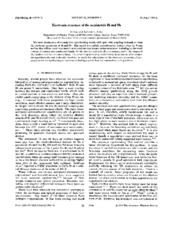| dc.creator | LIU, Y. | |
| dc.creator | Allen, Roland E. | |
| dc.date.accessioned | 2011-10-10T21:08:48Z | |
| dc.date.available | 2011-10-10T21:08:48Z | |
| dc.date.issued | 1995 | |
| dc.identifier.citation | Y. LIU and Roland E. Allen. Phys.Rev.B 52 1566-1577 1995."Copyright (1995) by the American Physical Society." | en |
| dc.identifier.uri | http://dx.doi.org/10.1103/PhysRevB.52.1566 | |
| dc.identifier.uri | https://hdl.handle.net/1969.1/127297 | |
| dc.description | Journals published by the American Physical Society can be found at http://journals.aps.org/ | en |
| dc.description.abstract | We have developed a third-neighbor tight-binding model, with spin-orbit coupling included, to treat the electronic properties of Bi and Sb. This model successfully reproduces the features near the Fermi surface that will be most important in semimetal-semiconductor device structures, including (a) the small overlap of valence and conduction bands, (b) the electron and hob effective masses, and (c) the shapes of the electron and:hole Fermi surfaces. The present tight-binding model treats these semimetallic properties quantitatively, and it should, therefore, be useful for calculations of the electronic properties of proposed semimetal-semiconductor systems, including superlattices and resonant-tunneling devices. | en |
| dc.language.iso | en | |
| dc.publisher | American Physical Society | |
| dc.subject | TRANSPORT-PROPERTIES | en |
| dc.subject | ENERGY-GAP | en |
| dc.subject | SEMICONDUCTORS | en |
| dc.subject | SUPERLATTICES | en |
| dc.subject | BISMUTH | en |
| dc.subject | HETEROSTRUCTURES | en |
| dc.subject | CRYSTALLINE | en |
| dc.subject | Physics | en |
| dc.title | Electronic-Structure of the Semimetals Bi and Sb | en |
| dc.type | Article | en |
| local.department | Physics and Astronomy | en |


